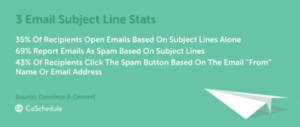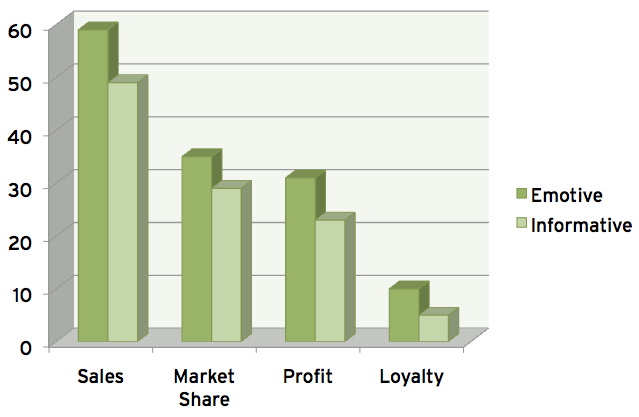Are your open rates plummeting?
Are you looking for subject lines that will get your subscribers to open your emails?
In this blog post, you will learn what kind of subject lines will get that email open.
Why Subject Lines Are So Important
Think about it for a moment, subject lines are the first thing your prospects will see before they open their email.
But don’t take my word for it. Here are some CoSchedule stats about the subject lines:

Based on the above stats, one out of three will open their email based on what YOU place in the subject line.
If you’re not careful, two out of three will even label your email as spam. If they don’t know you, almost half of your prospects will send your email to spam. That is — before they open it.
Imagine getting rejected even before you could lay down your sales pitch.
Here are 11 email subject lines that will make people open it.
1. Use Emotions
You’ll more likely get a positive response if you appeal to people’s emotion.
I can prove this.

This chart, courtesy of the Ignition Marketing Group, shows more people are ruled by emotions rather than logic.

Emotion is a powerful tool in your email subject line arsenal. According to Hubspot, urgency, curiosity, excitement, and joy are the best emotions to trigger your prospects.
- You can raise a sense of Urgency:
Get one now before stocks run out
- Make them Curious:
Mystery gift enclosed
- Create Excitement:
Save up to 50% off your favorite item
- Spread some Joy:
Merry Christmas from your insurers
2. Avoid Using Generic Subject Lines
A generic subject line is almost a guarantee that your email will go to spam. What you should do is personalize your subject line.
Here are some the methods you can use:
- Include a person’s name as sender, instead of a simple company name. For example, “John from Copy Masters” is seen as more trustworthy than just “Copy Masters.”
- Include your prospect’s name and location in the subject line to gain his or her trust.
- If you don’t know the prospect’s name, use the word “you” or “your” to make it appear that you are addressing them directly.
- Make sure you have some relevant background information about your subject. You wouldn’t send cat food promos to someone who doesn’t have cats or allergic to them.
3. Tease But Don’t Lie
You can tease about the product or service you’re selling but don’t lie or exaggerate.
And when you tease your readers, you also arouse their curiosity.
Here are a few examples of a teasing headline:
- “10 secrets that will double your sales”
- “Sales strategies that you’re not aware of”
- “Eating a lot without gaining weight is possible”
You’ll notice that the subject lines just have enough details to stimulate the reader’s’ interest.

4. Use Call to Action (CTA) Words
Just include enough words that will best describe your offer then add a CTA.
Here are a few examples:
- “Shop with these discount coupons”
- “Get your swimsuit”
- “Reserve your plane seats now”
The idea is to compel your readers to take some action.
5. Adding Humor Works
Humor is a great icebreaker especially if you’re doing cold email campaigns. It’s a good way to establish some sort of rapport with your prospective customers.
Here are a few examples:
- “Best ways to avoid your mother-in-law”
- “Coupons our staff would kill for”
- Mr. Beans will love our deals”

But…
See to it that the humor will not offend anyone. In this day and age, you have to take note of your reader’s cultural and religious background. What’s funny to a man may be seen as offensive from a woman’s viewpoint.
6. Avoid Using ALL CAPS and Don’t Use Too Many Exclamation Points
This is the usual practice in the email marketing campaign of the old days. But today, subject lines with ALL CAPS and plenty of exclamation points goes straight to SPAM.
Why?
Many spammy emails use this kind of subject line. It’s also rude since many readers will interpret it as a sign that you’re yelling at them. SO DON’T USE IT!!!!!!

7. Numbers Will Get Their Attention
A Yesware survey revealed that adding some number in the subject line can persuade your prospect to open your email.

Here are some examples:
- “Open now to get 50% off your favorite item”
- “4 sure ways to get fit”
- “Save $110/Month”
8. Ask a Question (But Use With Care)
Many of your readers are looking for solutions to problems that they faced at work or home. You can pick one of those questions and use it as an email subject line.

Benchmark suggests that after putting the question out, provide the answer immediately afterwards.
For example:
- “Want to boost sales? We know 5 ways you can use.”
- “Need an effective FB ad? We can provide one.”
9. The Science and Art of Right Timing
Timing can also help your email’s chances of getting open. For example, you can send an email that offers a discount that’s only available during the prospect’s birthday.
Timing will also help your email’s chances of getting open.
For example, you send an email that offers a discount that’s only available during the prospect’s birthday.
Another example, you email a renewal notice to your subscribers two weeks before their subscription expires. You can use an email subject line like, “Oh no, your subscription is about to expire.”
Emails with the appropriate subject line, sent at the right time will improve your open rate dramatically.
10. Emojis are Fun 😎 😎 😎🤠 😎🤠😝
You may have noticed in your inbox that some of the emails have emojis in them. They are fun and many readers can’t resist the urge to open those kinds of email.

But…
Make sure that the emojis can appear on your prospect’s computer or mobile phone. It’s still a new thing and you may need special software to use them.
11. People Still Like Free Stuff
You could include in the subject line that you’re giving a gift or some free stuff. This will get a lot of people to open your email.
“But Benjie, isn’t that an expensive strategy just to make people open my email?”
Not really.
A Time Magazine article documented how companies that give freebies are actually making money. Big companies like Proctor & Gamble are giving away thousands of free stuffs from razors to diapers. But they don’t consider the stuffs they gave away as a loss but rather as an investment.
In reality, the P&G strategy of giving free stuff is actually boosting their sales.
How can that be?
You see it has something to do with psychology. Somehow the free item makes the recipient obligated to return the favor by buying a P&G product.
What’s the bottom line?
Prospects will open your email ONLY if they will get some benefits from it. Your subject line is the best place to tell them about that.
- The 5 Powerful Ways To Boost Inbound Traffic - June 12, 2018
- How the 6 Persuasion Principles Helps Attract Your Target Audience - June 1, 2018
- 5 Tips to Create Attractive, Sexy Blog Titles - May 29, 2018

